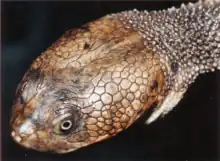Chelodina canni
Chelodina canni, also known commonly as Cann's snake-necked turtle, is a species of turtle in the family Chelidae. The species is endemic to Australia, where it is found in the northern and northeastern parts of the continent.[1] It has a narrow zone of hybridization with its related species the eastern snake-necked turtle, C. longicollis. For many years C. canni was assumed to be the same species as C. novaeguineae from New Guinea. However, in 2002 it was shown that these two species differ both morphologically and genetically, and therefore C. canni was separated and described as a unique species.
| Cann's snake-necked turtle | |
|---|---|
 | |
| Scientific classification | |
| Domain: | Eukaryota |
| Kingdom: | Animalia |
| Phylum: | Chordata |
| Class: | Reptilia |
| Order: | Testudines |
| Suborder: | Pleurodira |
| Family: | Chelidae |
| Genus: | Chelodina |
| Subgenus: | Chelodina |
| Species: | C. canni |
| Binomial name | |
| Chelodina canni | |
 | |
| Distribution of C. canni in Australia. | |
| Synonyms[2] | |
| |
Taxonomy
- Order: Testudines Linnaeus, 1758
- Suborder: Pleurodira Cope, 1864
- Family: Chelidae Ogilby, 1905
- Subfamily: Chelodininae Baur, 1893: 211[3]
Type data - Holotype: NTM 24515; an adult female (carapace length, CL = 215.3 mm; carapace width, CW8 = 167.2 mm), preserved in alcohol; collected with the help of local aboriginal people at Malogie Waterhole, near Scarlet Hill on Kalala Station (16° 08' S, 133° 36' E), Northern Territory, Australia.
Etymology - This species is named in honour of John Robert Cann (born 1938) of Sydney, Australia for his lifetime of work with the freshwater turtles of Australia.[4]
Taxonomic History - For many years this species was considered to be a secondary and disjunct population of Chelodina novaeguineae Boulenger, 1888.[5] In recent years many started to believe that this was not the case. An attempt to describe it as Chelodina rankini was made by Wells and Wellington (1985)[6] however this was shown to be a nomen nudum by Iverson et al., 2001,[7] the species was finally described by William McCord and Scott Thomson in 2002.
Subfamilies were resurrected for this family after it was discovered that the South American and Australian members are reciprocally monophyletic, that is they each have their nearest relatives within the continent (Georges et al., 1998).[8]
Description

Adults of C. canni can be diagnosed by the wide, rounded carapace with a moderately deep midvertebral trough; a median carapacial keel either absent or minimal, being most observable in the eastern populations; a wide plastron with dark seams on an otherwise uniformly yellow plastron; first and second marginal scutes equal or nearly equal in dorsal surface area; wide head with a red to pink suffusion on the head, neck, and limbs; and bluntly pointed neck tubercles. Hatchlings have an extensive orange-red ventral head, neck, and plastral pattern extending well onto the dorsal aspect of the marginal scutes.
Distribution
C. canni is known from the Roper River drainage (including Maria Island in the Gulf of Carpentaria) in Northern Territory, eastward through the drainages of the Gulf of Carpentaria in northwest Queensland. In Cape York it is found in drainages from Cairns in the north down to Rockhampton in the south where a narrow hybrid zone with C. longicollis is found (Georges et al., 2002).[9]

References
- McCord W, Thomson S (2002). "A new species of Chelodina (Testudines: Pleurodira: Chelidae) from Northern Australia". Journal of Herpetology 36 (2): 255-267.
- Turtle Taxonomy Working Group [van Dijk PP, Iverson JB, Rhodin AGJ, Shaffer HB, Bour R] (2014). Turtles of the World, 7th edition: annotated checklist of taxonomy, synonymy, distribution with maps, and conservation status. In: Rhodin AGJ, Pritchard PCH, van Dijk PP, Saumure RA, Buhlmann KA, Iverson JB, Mittermeier RA (Editors). Conservation Biology of Freshwater Turtles and Tortoises: A Compilation Project of the IUCN/SSC Tortoise and Freshwater Turtle Specialist Group. Chelonian Research Monographs 5(7):000.329–479, doi:10.3854/ crm.5.000.checklist.v7.2014.
- Baur G (1893). "Notes on the classification and taxonomy of the Testudinata". Proceedings of the American Philosophical Society 31: 210–225.
- Beolens, Bo; Watkins, Michael; Grayson, Michael (2011). The Eponym Dictionary of Reptiles. Baltimore: Johns Hopkins University Press. xiii + 296 pp. ISBN 978-1-4214-0135-5. (Chelodina canni, p. 47).
- Boulenger GA (1888). "On the chelydoid chelonians of New Guinea". Annali del Museo Civico di Storia Naturale di Genova. (2) 6: 449-452.
- Wells R, Wellington R (1985). "A classification of the Amphibia and Reptilia of Australia". Australian Journal of Herpetology, Supplementary Series 1: 1-61.
- Iverson J, Thomson S, Georges A (2001). "Validity of the taxonomic changes for turtles proposed by Wells and Wellington". Journal of Herpetology 35: 365-368.
- Georges A, Birrell J, Saint K, McCord WP, Donnellan S (1998). "A phylogeny for side-necked turtles (Chelonia: Pleurodira) based on mitochondrial and nuclear gene sequences". Biological Journal of the Linnean Society 67: 213-246.
- Georges A, Adams M, McCord W (2002). "Electrophoretic delineation of species boundaries within the genus Chelodina (Testudines: Chelidae) of Australia, New Guinea and Indonesia". Zoological Journal of the Linnean Society 134 (4): 401-422.
External links